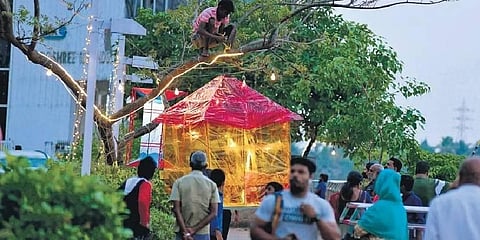

KOCHI: Christmas time is celebrated across Kerala with much love and joy, irrespective of religion. While Christians welcome the birth of Jesus Christ on Christmas, people belonging to other communities take up the festive spirit to usher in the New Year.
It is said that before the advent of the Portuguese in the 16th century, there weren’t many records of any big celebration during Christmas in this region, besides feasts held at churches. Most of these were dedicated to either St George or Mother Mary. Those days, the ‘Pindi Perunnal’ (epiphany of Jesus) was celebrated with more fervour. “Pindi Perunnal was also called the ‘Rakkuli Perunnal’ (ceremonial bath before lighting the lamps). It used to be the primary festival of ‘Nasranis’ or the Christians believed to have been baptised by St Thomas,” says Shalom World News deputy editor Renjith Leen.
“However, with the advent of the Portuguese, parts of Kerala started celebrating Christmas as well. Many churches in Kerala were Latinised in terms of architecture, artwork, and liturgy. The European way of celebrating the birth of Jesus soon started gaining popularity, even among Syrian Christians.”
Notably, it was the chefs of Portuguese who popularised many quintessential Christian dishes such as the stew and meat cutlets. Earlier, such dishes were largely confined to the coastal regions, especially among the Latin Catholic and Anglo-Indian communities.
“Even the tradition of hanging stars and setting up cribs gained popularity in Kerala only in the 20th century,” notes Renjith, who is a keen history researcher.“Initially, the stars were handmade, mostly using bamboo. There were a lot of western missionaries until the 1930s in many parts of Kerala, and they popularised the Italian and Portuguese styles of making cribs representing the birth of Jesus.”
The tradition of having wine, he adds, dates back to only a century ago, courtesy the Portuguese. “When inter-marriages happened among the people belonging to different churches, traditions and recipes started spreading across the region,” says Renjith. Christmas feasts became a common affair only in the post-Independence era. Earlier, pidi (rice dumpling) and erachi (meat) curry were the staple treats on Christmas day.
Santa tales
Now, it is tough to imagine Christmas without Santa Claus. “It was the Anglo-Indian settlements in Kollam, Kottayam, Alappuzha and Kochi that popularised Santa,” notes Renjith. “By the 1940-50s, the ‘Christmas pappa’ or Pappanji concept spread to other parts of Kerala, along with carols. The same applies to the Christmas tree, cake and wine, too.” By the 1950s, carols and revelry with sumptuous feasts became a regular affair during Christmastime.
“If you take the coastal Latin Catholics, especially in Kochi and Kollam, the dining table used to be full of dishes – in line with the old European concept that the table should ‘creak under the weight of the food’. There would be pork, beef and fish molly,” says Renjith. “It was mainly due to the influence of the Anglo-Indians. Most Christmas traditions, including culinary ones, originated from Kochi, Alappuzha and Kollam regions. In Fort Kochi and Kollam, there is a tradition of white-washing the house. It is a tradition followed in Portugal where houses are spruced up in white to welcome Baby Jesus.”